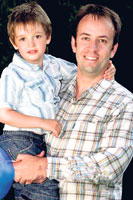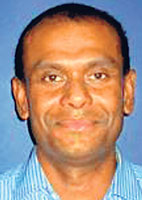A boy of four has been cured of a dangerous heart condition after it was spotted by the same surgeon who saved his father.
Little Harry Hepworth was thought to have a hole in his heart.
But during surgery to repair the hole, it was discovered he too suffered from the same life-threatening condition which affected his dad Martin.
Surgeon Nihal Weerasena only realised Harry had the defect because he operated on Mr. Hepworth for the condition three years previously.
 |
| Happy together: Father and son.
Pic courtesy rossparry.co.uk |
He managed to carry out the complex five-hour open-heart operation immediately at Leeds General Infirmary, leaving Harry with a clean bill of health for the rest of his life.
Son and dad suffer from partial anomalous pulmonary venous drainage - known as PAPVD - a condition where a hole in the heart means blood, normally separated by a wall, mixes together.
Martin, 37, of Roundhay, Leeds, said: "We now realise the condition is inherited down the male side of our family. "But there was no way to know Harry was suffering until a surgeon had a look inside. Luckily, because it was Mr. Weerasena, he was fully prepared for what might happen and was able to perform the different procedure."
Dr. Weerasena corrected the problem in both father and son by constructing a wall in the heart out of the patient's own tissue.
This directed the blood to the right area and stopped it from merging.
Father-of-two Martin, who runs his own IT company with wife Katie, 38, was born with a hole in his heart and had surgery in 1978 when he was six.
When daughter Eleanor, now six, was a baby he developed pneumonia and doctors discovered he needed another operation. But when surgeons began the keyhole procedure, they noticed that Martin had the condition PAPVD.
So in 2006 he had the more complex operation at Leeds General Infirmary, carried out by consultant cardiothoracic surgeon Mr. Weerasena.
 |
| The hero: Dr. Nihal Weerasena |
The surgeon said: "To have the exact same condition between father and son is extremely rare. Only about one per cent of the people I operate on have PAPVD, so it is amazing that a father and son both had it. I have never seen this before.They were lovely people and Harry was particularly brave considering how young he was. They are a remarkable family."
Martin added: "We know now that the worst thing you can do to somebody with PAPVD is patch up a hole in the heart because it can make the problem worse.
"They actually think that I have been relatively okay because my heart must have blown the patch off.
"For Harry to not have to go through what I have gone through is marvellous. It has affected my life. I was a poorly child and it had been my ambition to join the police force but I could never do that. I have a pacemaker and will be on drugs for the rest of my life. For Harry it will be totally different.
"He is now very active and loves nothing more than to be out on his bike, he also loves his trampoline and bowling. He has got so much energy, whereas before surgery he was quite slow and got tired quickly.
"Because he had been like that from birth it is difficult to see how much of it was due to him being a toddler or down to his own personality. "But now we see a marked difference. It's brilliant to see the change in him and it is brilliant what Mr. Weerasena has done for us.
"We appreciate that even armed with the knowledge of PAPVD it is still difficult to spot, especially when he had such a big job ahead.
"We are very grateful for how he has given our family a new lease of life." – Courtesy Daily Express
What is PAPVD?
Partial anomalous pulmonary venous drainage, or PAPVD, is a condition that allows blood in the heart normally separated by a wall to mix together through a hole.
The hole allows blue unoxygenated blood, which goes out to the lungs and pink oxygenated blood, which comes back from them, to merge. This extra fluid can cause the heart to enlarge and work harder, leaving sufferers feeling sluggish and tired.
If left untreated, it would shorten life expectancy.
PAPVD exists when one or more of the pulmonary veins drain to the left atrium while the other vein is connected to right atrium.
The result is that some oxygen-rich blood is returned to the right atrium and mixes with venous blood and is then returned to the lungs instead of flowing out of the heart to the body. This makes the right side of the heart work harder.
– Courtesy Yorkshire Post
|


